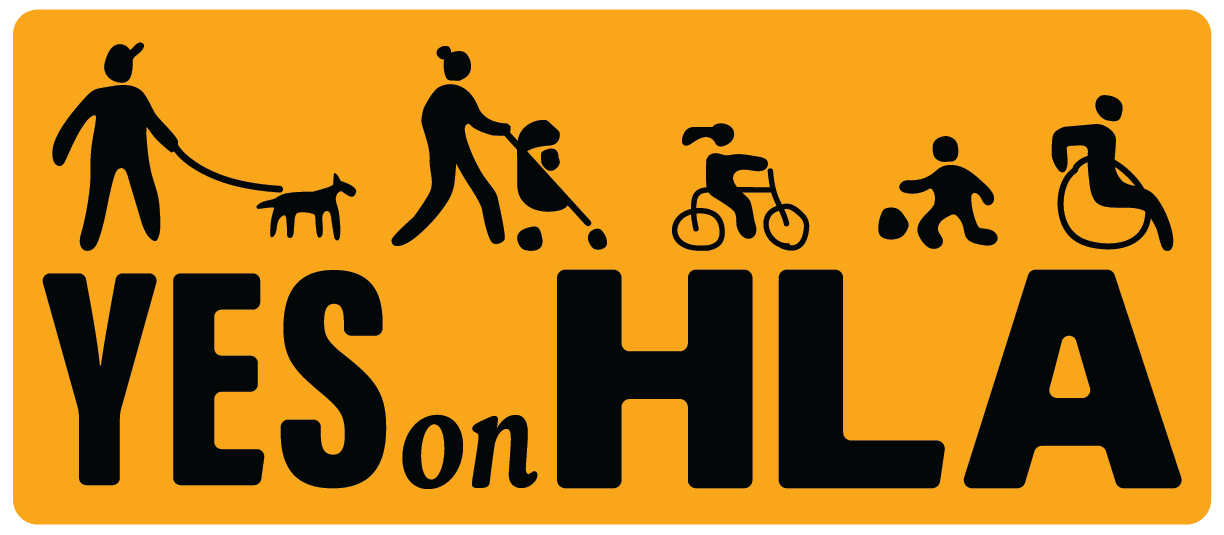Traffic fatalities among cyclists and pedestrians are skyrocketing. Several outlets already made news reporting that in 2023, traffic deaths outpaced homicide deaths in Los Angeles. In fact, according to the Measure HLA campaign, 337 traffic fatalities were recorded last year, more than any time in L.A. history and the most of any city in the country. Cars are now also the number one killer of children in L.A. County.
It’s well past time solutions are implemented to not only dramatically cut down on this statistic, but make the city one of multi-mobility solutions friendlier to cyclists and pedestrians. We believe Measure HLA (or “Healthy Streets L.A.”) on the ballots of Los Angeles voters will help do this. Vote Yes.
There is no worse public policy than the good public policy that sits on a shelf. Almost a decade ago, in 2015, Los Angeles agreed to a strong, practical, and (even then) overdue plan, “Mobility Plan 2035,” as part of the city’s General Plan Update. The plan recognized the dangers of streets that were neither being properly maintained nor being made safer for walkers and bikers. In so doing, it hoped to make those mobility options more attractive to help unclog our streets.
Mobility Plan 2035 also called for the creation of hundreds of miles of Bus Only lanes to dedicate less cluttered streets to greater travel efficiency for bus riders and better protect cyclists. But what was committed to overall in the Mobility Plan hasn’t even registered a blip. According to the Measure HLA team, only five percent of the total plan has been implemented. At that rate, it would take 160 years to complete. Will we even be driving cars at that point? Measure HLA cuts it down to between 5 and 15 years.
Measure HLA has a simple solution: Require the city to implement its own Mobility Plan. It does so by demanding that when the Los Angeles Department of Transportation (LADOT) repaves city streets – at about a 500 miles a year pace – the other called-for improvements be made by the department at the same time. The Network Mobility Plan within the larger plan outlines six Network categories:
- Pedestrian Enhanced
- Transit Enhanced
- Bike Enhanced
- Bike Lane
- Neighborhood Enhanced
- Vehicle Enhanced
When paving begins, LADOT will simply incorporate the improvements in each Network category that have been outlined. This will streamline multiple permitting processes down to one larger process for each item in the collection of improvements, saving time and money.
This would put Los Angeles on a route modeled by Cambridge, Massachusetts, Providence, Rhode Island, and Seattle, Washington.
Measure HLA has its critics, and we’re disappointed that Westside Councilmember Traci Park is among them. She has raised red flags around the cost of the project, especially given the city’s current structural deficits. But Park is using a flawed estimate by the City’s Chief Administrative Officer (CAO), which the Yes campaign claims overstates program dollars by more than a whopping $2 Billion.
The Yes side argues that the CAO is assuming the Plan includes large costs for sidewalk repairs, but HLA does not require sidewalk repairs at all. In addition, if the final costs of a recent four-year bike lane improvement effort are to be believed, the CAO has overestimated that Network by four times the amount that was actually spent.
In fact, Measure HLA will have a negligible if any effect on the General Fund. Nearly $1 Billion was allocated for transportation-related spending last year, most of which came from special dedicated funds that can’t be spent on anything other than transportation projects. None of that is General Fund money.
Another financial kicker? The city spends between $5-17 Million annually in wrongful death lawsuits, many related to traffic fatalities. Measure HLA will lead to the kind of transit improvements that will cut down this number.
In yet another example, the Yes on Measure HLA campaign writes, “The recent San Vicente project – an example of the kind of project Measure HLA would lead to, with the City implementing its own Mobility Plan when repaving – cost around $250,000. The project was 1.25 miles in length. This leads to a per-mile cost of $200,000 per mile, or 89% less than the CAO’s estimate.”
Park has also concerned herself with adverse traffic effects for major thoroughfares like Lincoln and Venice Blvds. But Lincoln is a state highway, with little the Mobility Plan can do there. And when portions of Venice Blvd were improved several years ago along the lines called for here, the LADOT study before and after improvements showed minimal slowdowns in vehicle traffic:
- Eastbound p.m. rush increased by 91 seconds
- Eastbound a.m. rush increased by 14 seconds
- Westbound p.m. rush increased by 3 seconds
- Westbound a.m. rush increased by 46 seconds
We think Councilmember Park is listening to the wrong people, namely the NIMBYs and car cranks that will ALWAYS voice displeasure with any road improvements that alter their lives in even the smallest of ways. We encourage voters not to listen to those folks.
Vote Yes on HLA and feel good about a measure that will bring a newer, safer, and cleaner mobility future to Los Angeles at a faster pace.
Logo image provided by the Yes on Measure HLA campaign
Stay informed. Sign up for The Westside Voice Newsletter
By clicking submit, you agree to share your email address with Westside Voice. We do not sell or share your information with anyone.








